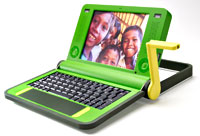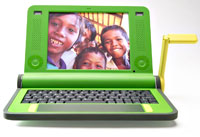 Yesterday, a spokesperson for the One Laptop Per Child (OLPC) programme revealed that Nigeria, Brazil, Argentina, and Thailand have all tendered commitments to purchase one million Linux laptops through the ambitious US-based programme.
Yesterday, a spokesperson for the One Laptop Per Child (OLPC) programme revealed that Nigeria, Brazil, Argentina, and Thailand have all tendered commitments to purchase one million Linux laptops through the ambitious US-based programme.
As we reported back in November last year, OLPC aims to distribute millions of Linux-based laptop computers to needy children in developing countries around the world, all for free.
The Linux-based laptops come with their own power sources (including wind-up) and offer a dual-mode display, which gives users a full-colour, transmissive DVD mode and a secondary black and white reflective and sunlight-readable display at 3× the resolution.
The hard-disk free machines – still in the ‘concept’ stage – will be powered by a 500MHz processor and 128MB of DRAM, and come with 500MB of Flash memory.
Sporting four USB ports, the laptops will be fitted with wireless broadband that allows them to work as a mesh network.
 This means that each laptop will be able to talk to its nearest neighbour and create ad hoc, local area networks for sharing data and connections.
This means that each laptop will be able to talk to its nearest neighbour and create ad hoc, local area networks for sharing data and connections.
The OLPC has stated that it will begin production when it has paid-for orders for between five million and 10m laptops, and plans to have units ready for shipment by the end of 2006 or early 2007.
Nicholas Negroponte, head of the OLPC project and former director of MIT Media Labs also sees the project as a means to promote the mass adoption of Linux.
 So far, AMD, eBay, Google, Nortel, Red Hat, and a number of other technology companies have all signed up to help support the project
So far, AMD, eBay, Google, Nortel, Red Hat, and a number of other technology companies have all signed up to help support the project
Not everyone is so enthusiastic about the project though, with India’s Education Secretary Sudeep Banerjee describing it as “pedagogically suspect,” adding that the country needed to put teachers in classrooms before worrying about buying laptops for students.
(To be honest, we had to look up what ‘pedagogically’ meant, and can tell you that it means “In a didactic manner”)